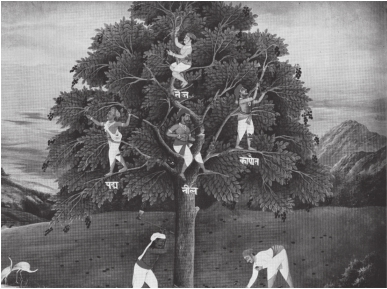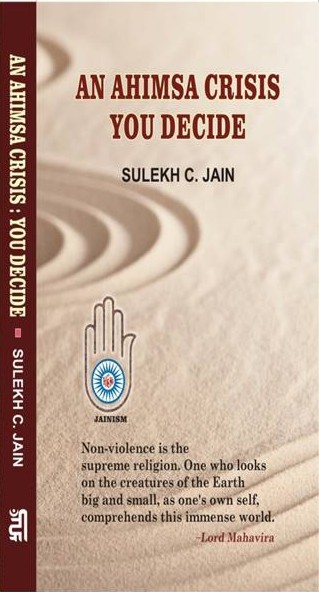Himsa, and hence inflow of karmas, depend upon:
- The levels with which the faculties of mind, speech and physical actions to commit himsa are engaged,
- Timing, intention, circumstances, and the
- Intensity and duration of engagement of the aforementioned three faculties in doing the action.
Based on the above, the results of action and binding (bandh) of karmas can be of following types:
- Like drawing a line in air. This “mark” lasts only a few milliseconds. Here the level of himsa is very low (mostly momentarily and held in one’s mind) and its effects can be much reduced or completely eliminated by contemplation, realizing the mistake and expressing repentance, and asking for forgiveness genuinely.
- Like drawing a line in water. Here the effect of himsa may last a little longer but its intensity, results, and the level of inflow of karmas can be reduced by realizing the mistake, taking responsibility, and doing some repentance and penance.
- Like drawing a line in sand. The effect of this himsa is much longer lasting but its results can still be reduced by observing sincere penance and repentance.
- Like drawing a line in stone or steel. This is also called anootaanbandhi and is the severest type of himsa. This is a permanent line and cannot easily be eliminated. The doer must bear its fruits and suffer punishment.
The following metaphor illustrates the level or degree of himsa situations that we all come across in life. Imagine an apple tree and a hungry man. He has many choices, including:
- He can pick up only those apples that are already fallen on the ground. By doing so, he commits the least amount of himsa, if any.
- He can raise his hands, grab a branch of the apple tree, and pluck however many apples he needs to satiate his hunger. Here the degree or level of himsa is slightly greater.
- He might shake the whole apple tree. Many apples fall on the ground whereas he needs only a few for his needs. The level of himsa has increased significantly as he has expended energy against the tree beyond his needs.
- He cuts a branch of the tree, from whence he picks a few apples for his needs. Obviously this level of himsa is unnecessary.
- He cuts down the entire tree, so that no one can ever pluck apples from it again. This is a case of extreme himsa.
The image above, illustrating the metaphor, allows us to reflect upon whether the amount of himsa being done is necessary, moral, and unavoidable, or whether it can be reduced, minimized, or avoided entirely. In life, there are always such choices.
In the following paragraphs we describe the hierarchy of himsa and inflicted pain, as well as the actions and modes that
cause himsa.

The level and intensity of suffering can best be described by asking the following question, “Is the level and intensity of suffering inflicted on a living being the same no matter how many senses that being possesses?”
The answer to this question is, simply, “no.” The level of pain and suffering experienced by a jiva is not the same for all jivas. It depends upon the number of pranas (life forces) in various life forms. Thus, there is a hierarchy of various life forms.
In a paper titled “Comprehensive Concept of Ahimsa; Its Application in Real Life,”[8] D.R. Mehta writes that:
…the principle of equality of souls is…at times applied or understood wrongly. In Jain canons the synonym of Himsa or violence is the expression ‘pranatipata,’ which means that the sin of killing is in proportion to the pranas (life forces) taken. It is a subtle aspect, which needs to be explained. Soul is indestructible and what can be killed is only the body. For bodies, Lord Mahavira gives a fivefold classification. According to him, bodies are one-sensed, two-sensed, three-sensed, four-sensed and five-sensed. The micro level creatures in air, water, earth, etc. are one-sensed. On the other hand, human beings or other large creatures have five senses. The level of prana in these categories of life forms increases with the number of senses. For example human beings have ten pranas. According to Lord Mahavira, the killing of a human being is far more sinful than the killing of lower forms of lives possessing lesser number of pranas by being a vegetarian rather than a meat eater.
An ahimsak respects the hierarchy of one-sensed through five-sensed life forms. He knows that all life forms are not equal in terms of the degree of himsa (pain and suffering) felt. Thus he bases his daily actions and living on this hierarchy. An ahimsak seeks to exclude, as far as possible and practical, all forms of exploitation of, and cruelty to, all living beings for food, clothing, or for any other purpose.
Shown below is a summary of the number of pranas, and the pain and suffering experienced by a jiva:
- One-sensed beings have four pranas; these include: life span, physical power, respiration, and sense of touch.
- Two-sensed beings have six pranas, including: life span, physical power, respiration, sense of touch and taste, and vocal power.
- Three-sensed beings have seven pranas, including: life span, physical power, respiration, sense of touch, taste and smell, and vocal power.
- Four-sensed beings have eight pranas, including: life span, physical power, respiration, sense of touch, taste and smell, seeing, and vocal power.
- Five-sensed (non-sentient jiva) beings have nine pranas; these include: life span, physical power, respiration, sense of touch, taste, and smell, seeing and hearing, and vocal power.
- Five-sensed (sentient jiva) beings have ten pranas, including: life span, physical power, respiration, sense of touch, taste, and smell, and seeing, hearing, vocal power, and mental power.
The above hierarchy of existence and the levels of suffering tell us that the level of pain inflicted in a plant-based diet is much less than in an animal-based diet.
 Dr. Sulekh Chand Jain
Dr. Sulekh Chand Jain
